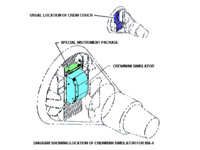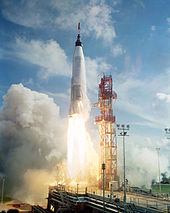- Mercury-Atlas 4
-
Mercury-Atlas 4 Mission insignia

Mission statistics Mission name Mercury-Atlas 4 Spacecraft mass 1,224.7 kilograms (2,700 lb) Crew size 0 Call sign MA-4 Launch vehicle Atlas LV-3B #88-D Launch pad LC-14 (CCAF) Launch date September 13, 1961, 14:09:00 UTC Landing September 13, 1961, 15:58:20 UTC Mission duration 01:49:40 Number of orbits 1 Apogee 248 kilometres (134 nmi) Perigee 156 kilometres (84 nmi) Orbital period 88.6 min. Orbital inclination 32.57° Distance traveled 41,919 kilometres (26,047 mi) Maximum velocity 28,205 kilometres per hour (17,526 mph) Peak acceleration 75.5 m/s² (7.7 g) Crew photo 
Crewman Simulator Related missions Previous mission Subsequent mission  MR-4
MR-4 MS-1
MS-1Mercury-Atlas 4 was an unmanned spaceflight of the Mercury program. It was launched on September 13, 1961 at 14:09 UTC from Launch Complex 14 at Cape Canaveral, Florida. A Crewman Simulator instrument package was aboard. The craft orbited the Earth once.
This flight was an orbital test of the Mercury Tracking Network and the first successful orbital flight test of the Mercury program. (All previous successful launches were suborbital.) The payload consisted of a pilot simulator (to test the environmental controls), two voice tapes (to check the tracking network), a life support system, three cameras, and instrumentation to monitor levels of noise, vibration and radiation. It demonstrated the ability of the Atlas LV-3B rocket to lift the Mercury capsule into orbit, of the capsule and its systems to operate completely autonomously, and succeeded in obtaining pictures of the Earth. It completed one orbit prior to returning to Earth. The capsule was recovered 176 miles east of Bermuda. One hour and 22 minutes after splashdown the destroyer USS Decatur (DD-936) (which was 34 miles from the landing point) picked up the capsule. On the MA-4 mission, all flight objectives were successfully achieved.
The mission used Mercury spacecraft # 8A (which had also been launched on the aborted MA-3 mission as spacecraft # 8) and Atlas # 88-D.
See also
Project Mercury Missions Unmanned: Little Joe 1 · Big Joe 1 · Little Joe 6 · Little Joe 1A · Little Joe 2 · Little Joe 1B · Beach Abort · Mercury-Atlas 1 · Little Joe 5 · Mercury-Redstone 1 · Mercury-Redstone 1A · Mercury-Redstone 2 · Mercury-Atlas 2 · Little Joe 5A · Mercury-Redstone BD · Mercury-Atlas 3 · Little Joe 5B · Mercury-Atlas 4 · Mercury-Scout 1 · Mercury-Atlas 5
Manned: Mercury-Redstone 3 · Mercury-Redstone 4 · Mercury-Atlas 6 · Mercury-Atlas 7 · Mercury-Atlas 8 · Mercury-Atlas 9Subprograms Rockets See also: Mercury 13 · Mercury Seven · Navy Mark IV ← 1960 · Orbital launches in 1961 · 1962 → Samos 2 | Tyazhely Sputnik | Venera 1 | Explorer 9 | Discoverer 20 | Discoverer 21 | Transit 3B · LOFTI-1 | S-45 | Korabl-Sputnik 4 | Korabl-Sputnik 5 | Explorer 10 | Discoverer 22 | Discoverer 23 | Vostok 1 | Mercury-Atlas 3 | Explorer 11 | S-45A | Discoverer 24 | Discoverer 25 | Transit 4A · Solrad 3 · Injun 1 | S-55 | Discoverer 26 | TIROS-3 | Midas 3 | Discoverer 27 | Discoverer 28 | Vostok 2 | Explorer 12 | Ranger 1 | Explorer 13 | Discoverer 29 | Samos 3 | Discoverer 30 | Mercury-Atlas 4 | Discoverer 31 | Discoverer 32 | Midas 4 · Westford 1 | Discoverer 33 | DS-1 No.1 | Mercury-Scout 1 | Discoverer 34 | Discoverer 35 | Transit 4B · TRAAC | Ranger 2 | Samos 4 | Mercury-Atlas 5 | Zenit-2 No.1 | Discoverer 36 · Oscar 1 | DS-1 No.2 | FTV-2203Payloads are separated by bullets ( · ), launches by pipes ( | ). Manned flights are indicated in bold text. Uncatalogued launch failures are listed in italics. Payloads deployed from other spacecraft are denoted in brackets. Categories:- Mercury program
- 1961 in spaceflight
Wikimedia Foundation. 2010.


